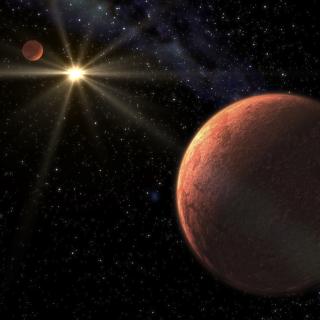Bibcode
Trifonov, T.; Lee, M. H.; Kürster, M.; Henning, Th.; Grishin, E.; Stock, S.; Tjoa, J.; Caballero, J. A.; Wong, K. H.; Bauer, F. F.; Quirrenbach, A.; Zechmeister, M.; Ribas, I.; Reffert, S.; Reiners, A.; Amado, P. J.; Kossakowski, D.; Azzaro, M.; Béjar, V. J. S.; Cortés-Contreras, M.; Dreizler, S.; Hatzes, A. P.; Jeffers, S. V.; Kaminski, A.; Lafarga, M.; Montes, D.; Morales, J. C.; Pavlov, A.; Rodríguez-López, C.; Schmitt, J. H. M. M.; Solano, E.; Barnes, R.
Referencia bibliográfica
Astronomy and Astrophysics
Fecha de publicación:
6
2020
Revista
Número de citas
24
Número de citas referidas
21
Descripción
Context. GJ 1148 is an M-dwarf star hosting a planetary system composed of two Saturn-mass planets in eccentric orbits with periods of 41.38 and 532.02 days.
Aims: We reanalyze the orbital configuration and dynamics of the GJ 1148 multi-planetary system based on new precise radial velocity measurements taken with CARMENES.
Methods: We combined new and archival precise Doppler measurements from CARMENES with those available from HIRES for GJ 1148 and modeled these data with a self-consistent dynamical model. We studied the orbital dynamics of the system using the secular theory and direct N-body integrations. The prospects of potentially habitable moons around GJ 1148 b were examined.
Results: The refined dynamical analyses show that the GJ 1148 system is long-term stable in a large phase-space of orbital parameters with an orbital configuration suggesting apsidal alignment, but not in any particular high-order mean-motion resonant commensurability. GJ 1148 b orbits inside the optimistic habitable zone (HZ). We find only a narrow stability region around the planet where exomoons can exist. However, in this stable region exomoons exhibit quick orbital decay due to tidal interaction with the planet.
Conclusions: The GJ 1148 planetary system is a very rare M-dwarf planetary system consisting of a pair of gas giants, the inner of which resides in the HZ. We conclude that habitable exomoons around GJ 1148 b are very unlikely to exist.
Aims: We reanalyze the orbital configuration and dynamics of the GJ 1148 multi-planetary system based on new precise radial velocity measurements taken with CARMENES.
Methods: We combined new and archival precise Doppler measurements from CARMENES with those available from HIRES for GJ 1148 and modeled these data with a self-consistent dynamical model. We studied the orbital dynamics of the system using the secular theory and direct N-body integrations. The prospects of potentially habitable moons around GJ 1148 b were examined.
Results: The refined dynamical analyses show that the GJ 1148 system is long-term stable in a large phase-space of orbital parameters with an orbital configuration suggesting apsidal alignment, but not in any particular high-order mean-motion resonant commensurability. GJ 1148 b orbits inside the optimistic habitable zone (HZ). We find only a narrow stability region around the planet where exomoons can exist. However, in this stable region exomoons exhibit quick orbital decay due to tidal interaction with the planet.
Conclusions: The GJ 1148 planetary system is a very rare M-dwarf planetary system consisting of a pair of gas giants, the inner of which resides in the HZ. We conclude that habitable exomoons around GJ 1148 b are very unlikely to exist.
Proyectos relacionados

Estrellas de Baja Masa, Enanas Marrones y Planetas
Se investigan los procesos que conducen a la formación de estrellas de baja masa, enanas marrones y exoplanetas y caracterizar las propiedades físicas de estos astros en varias etapas evolutivas. Las estrellas de muy baja masa y las enanas marrones son probablemente los objetos más numerosos de nuestra Galaxia, pero no por ello están
Rafael
Rebolo López

Exoplanetas y Astrobiología
La búsqueda de vida en el Universo se ha visto impulsada por los recientes descubrimientos de planetas alrededor de otras estrellas (los llamados exoplanetas), convirtiéndose en uno de los campos más activos dentro de la Astrofísica moderna. En los últimos años los descubrimientos cada vez más numerosos de nuevos exoplanetas y los últimos avances
Enric
Pallé Bago